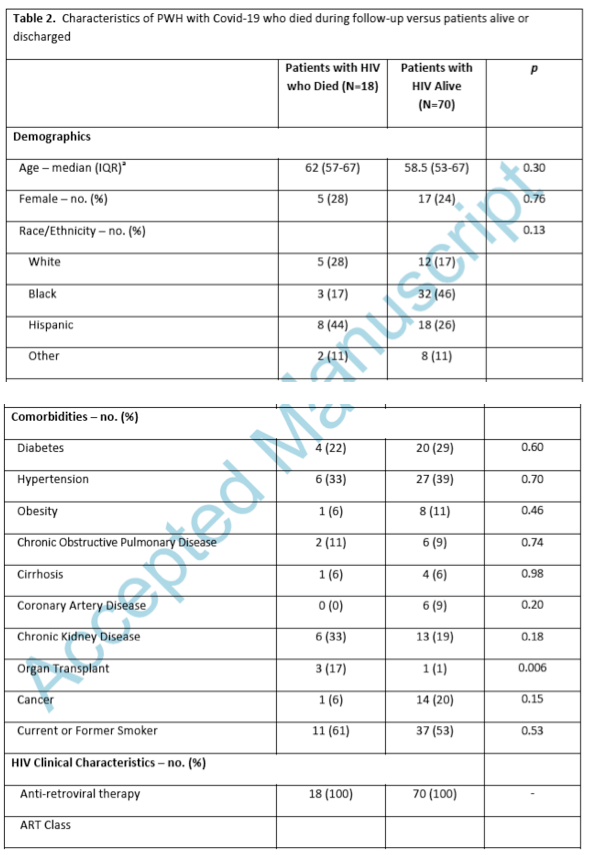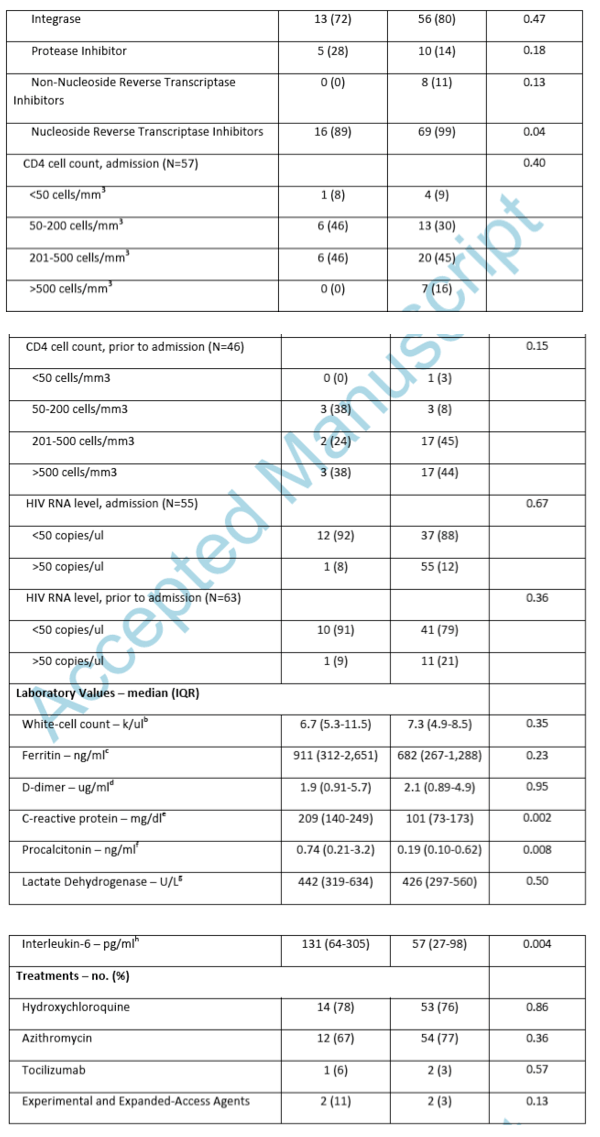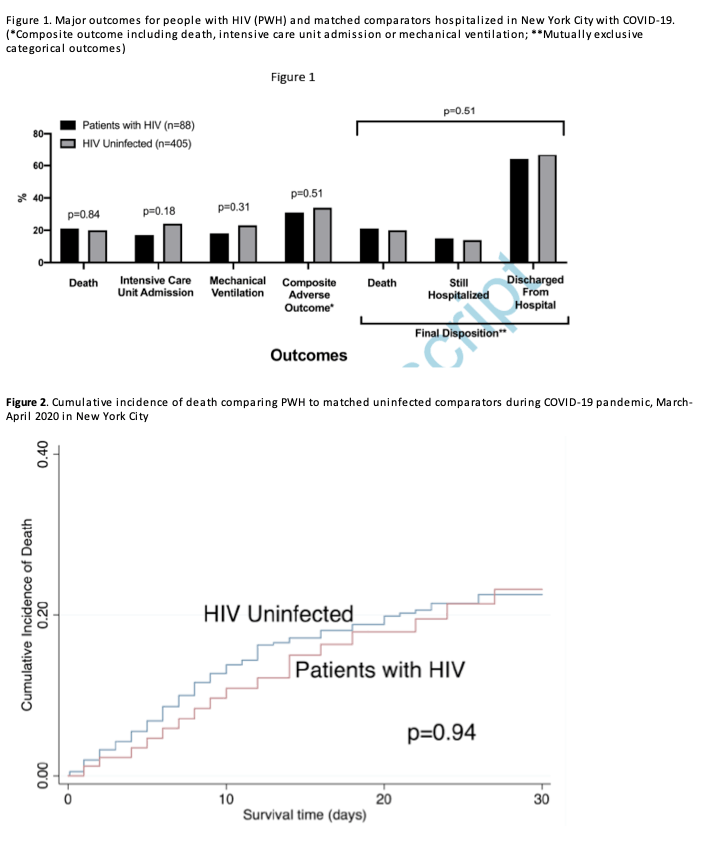| |
Covid-19 and People with HIV Infection:
Outcomes for Hospitalized Patients in New York City
|
| |
| |
Download the PDF here
"Poor outcomes for hospitalized PWH were frequent but similar to proportions in comparators; 18% required mechanical ventilation and ultimately 21% died during follow-up (compared with 23% and 20% respectively).......We found no differences in adverse outcomes associated with HIV infection for hospitalized COVID-19 patients compared to a demographically similar patient group."
A look at Table 2 below HIV+ with high CRP & Interleukin-6 died more frequently. Of those 18 HIV+ who died 46% died with CD4 50-200, 46% died who had 200-500 CD4, and HIV+ with >500 no one died. Those with higher Procalcitonin died more frequently. See table 2 for HIV+ who died who had diabetes, hypertension, kidney disease, smokers, obesity, COPD, cancer etc. Jules
[Procalcitonin is a substance produced by many types of cells in the body, often in response to bacterial infections but also in response to tissue injury. The level of procalcitonin in the blood can increase significantly in systemic bacterial infections and sepsis]
"Higher CRP values were present in PWH with more severe COVID-19 on admission (Table S2; p=0.005). The majority of PWH were treated with hydroxychloroquine and azithromycin; experimental or expanded-access agents were used less frequently....PWH with higher median CRP and procalcitonin levels on admission were also more likely to die during admission (both p<0.008). In separate models adjusting for age, sex and race/ethnicity significance persisted for organ transplant recipient status (sub-hazard ratio for death [SHR]: 3.85; 95% confidence interval [CI]: 1.87-7.94) and NRTI use (SHR 0.31; 05% CI: 0.12-0.80) as predictors of death for PWH. ... Antiretroviral medications have been evaluated for treatment of COVID-19 infection.[26] Several agents, including lopinavir and ritonavir, have demonstrated possible in-vitro activity against SARS-CoV-2.[27, 28] We found an adjusted association between NRTI use and lower mortality, although our analyses were not subject to correction for multiple statistical tests and could have been confounded by other factors.
Of the 4,402 patients hospitalized during the study period for COVID-19, 88 (2%) were PWH....Of the 4,402 patients hospitalized during the study period for COVID-19, 88 (2%) were PWH....Most hospitalized PWH were discharged from the hospital during the follow-up period (Figure 1). There was no significant difference in intensive care use by HIV status in our cohort. Poor outcomes for hospitalized PWH were still frequent but similar to proportions in comparators; 18% required mechanical ventilation and 21% died during follow-up compared with 23% and 20%, respectively. Competing risks analysis showed similar cumulative incidence of death over time by HIV status with no significant difference in the curves (p=0.94; Figure 2). HIV was not significantly associated with risk of death in multivariable competing risks analysis after adjusting for demographics, COPD, smoking, baseline ferritin level and baseline white blood cell count (Table S3)."
---------------------------
Accepted manuscript
Covid-19 and People with HIV Infection: Outcomes for Hospitalized Patients in New York City
Clinical Infectious Diseases 28 June 2020 - Alexander Charney, MD, PhD, Benjamin S Glicksberg, PhD, Eddye Golden, MPH, Erwin Bottinger, MD, Felix Richter, PhD, Francesca Cossarini, MD, Girish Nadkarni, MD, MPH, CPH, Ishan Paranjpe, Jessica K De Freitas, Judith Aberg, MD, Keith Sigel, MD, PhD, Michael Mullen, MD, Miriam Merad, PhD, Paz Polak, PhD, Riccardo Miotto, PhD, Sacha Gnjatic, PhD, Saurabh Mehandru, MD, Shan Zhao, MD, Stephanie Factor, MD, MPH, Sulaiman Somani, Talia Swartz, MD, PhD, Tinaye Mutetwa, MS, Zahi Fayad, PhD
https://academic.oup.com/cid/article/doi/10.1093/cid/ciaa880/5864410
Abstract
Background
There have been limited data regarding the clinical impact of COVID-19 disease on people with HIV (PWH). In this study we compared outcomes for PWH with COVID-19 disease to a matched comparison group.
Design
We identified 88 PWH hospitalized with laboratory confirmed COVID-19 in our hospital system in New York between March 12 and April 23, 2020. We collected data on baseline clinical characteristics, laboratory values, HIV infection status, COVID-19 treatment, and outcomes from this group and matched comparators (one PWH to up to five patients by age, sex, race/ethnicity and calendar week of infection). We compared baseline clinical characteristics and outcomes (death, mechanical ventilation, hospital discharge) for these two groups, as well as cumulative incidence of death by HIV status.
Results
Patients did not differ significantly by HIV status by age, sex or race/ethnicity due to the matching algorithm. PWH hospitalized with COVID-19 had high proportions of HIV virologic control on antiretroviral therapy. PWH had greater proportions of smoking (p<0.001) and comorbid illness than demographically similar uninfected comparators. There was no difference in COVID-19 severity on admission by HIV status (p=0.15). Poor outcomes for hospitalized PWH were frequent but similar to proportions in comparators; 18% required mechanical ventilation and ultimately 21% died during follow-up (compared with 23% and 20% respectively). There was similar cumulative incidence of death over time by HIV status (p=0.94).
Interpretation
We found no differences in adverse outcomes associated with HIV infection for hospitalized COVID-19 patients compared to a demographically similar patient group.
Study Cohort
We identified all hospitalized patients with laboratory confirmed SARS-CoV-2 infection at five hospitals in the Mount Sinai Health System admitted between March 12 and April 23, 2020. From this cohort we identified 88 patients with HIV-related diagnostic codes or those being treated with antiretroviral medications identified from inpatient or outpatient medication orders. We then selected an HIV uninfected comparator group (from the larger laboratory confirmed SARS-CoV-2 cohort) using a similar methodology to that used by the Veterans Aging Cohort Study for comparisons by HIV status.[5] We identified 405 HIV uninfected patients, matching one PWH to up to five patients by age (+/- 2.5 years), sex, race/ethnicity, and calendar week of infection (to account for temporally associated changes in COVID-19 management and differences in follow-up time).
Variables
Electronic health record (EHR) data were then collected including demographics, all diagnostic codes and procedures, as well as clinical laboratory measurements and outcomes (death, mechanical ventilation, discharge). Smoking status was ascertained from a structured EHR element. Oxygen supplementation requirements on admission were collected, verified via chart review and used to categorize COVID-19 severity using published criteria.[6] Laboratory values (white blood cell count, creatinine, alanine aminotransferase [ALT], ferritin, D-dimer, C-reactive protein [CRP], procalcitonin, lactate dehydrogenase and IL-6) reflected the admission value, collected within 48 hours of hospital presentation. Comorbidities were defined using relevant diagnostic codes (International Classification of Diseases 10th Edition). The most recent value prior to hospital admission during the preceding 12 months were determined for prior CD4, CD4 percentage of lymphocytes, and HIV viral load measurements and each of these biomarkers were also ascertained, when available, after the diagnosis of COVID-19 disease. HIV status, HIV clinical variables and antiretroviral medications were confirmed by chart review by two infectious diseases physicians (KS and TS). Adverse outcomes included death and mechanical ventilation, which were identified from electronic records and confirmed by chart review.
Finally, we compared characteristics of PWH who died during hospitalization to those who were discharged or still alive at the end of follow-up. We explored the independent association of significant factors associated with death for PWH from COVID-19 by fitting separate multivariable competing risk models using demographic factors and significant univariate predictors (one model for each predictor). Based on our sample size, our primary analysis of proportion of hospital deaths by HIV status had 80% power to detect a 15% increase in the absolute risk of death for PWH compared to uninfected persons. All analyses were conducted using STATA Version 15. This study was approved by our Institutional Review Board.
Results
Of the 4,402 patients hospitalized during the study period for COVID-19, 88 (2%) were PWH. The median age of PWH hospitalized with COVID-19 disease was 61 (Table 1; intraquartile range [IQR] 54-67) and most PWH were black (40%) or Hispanic/Latino (30%). Patients did not differ significantly by HIV status when comparing age, sex, or race/ethnicity due to the matching algorithm.
Consistent with trends noted in HIV cohort studies,[9] PWH also had greater proportions of smoking (55% versus 23%; p<0.001) and comorbid illnesses than demographically-similar uninfected comparators, most notably chronic obstructive pulmonary disease (COPD; 10% vs. 3%; p<0.001), cirrhosis (6% vs. 2%; p=0.02) and a history of cancer diagnosis (17% vs. 6%; p=0.001).
PWH and uninfected persons had similar COVID-19 severity on admission as measured by oxygen supplementation requirements (p=0.15).
All PWH admitted for COVID-19 were prescribed antiretroviral therapy and most (78%) were receiving integrase inhibitor-based regimens. The majority (58%) of patients with CD4 measurements on hospital admission had counts >200 cells/mm3 although among the 26 patients from this group with available prior CD4 percentage measurements (within 12 months), 73% had lower CD4 percentage levels on admission (median decline 4% [IQR 0-9%]). Among PWH with HIV viral RNA testing on admission or in the 12 months prior, proportions of viral suppression were high (81%).
Inflammatory markers including ferritin, CRP, and d-dimer were measured for most hospitalized PWH. Laboratory measures on admission were similar for PWH and uninfected patients except for lower ferritin (p=0.002) and white blood cell counts (p=0.02) for PWH. Higher CRP values were present in PWH with more severe COVID-19 on admission (Table S2; p=0.005). The majority of PWH were treated with hydroxychloroquine and azithromycin; experimental or expanded-access agents were used less frequently.
Most hospitalized PWH were discharged from the hospital during the follow-up period (Figure 1). There was no significant difference in intensive care use by HIV status in our cohort. Poor outcomes for hospitalized PWH were still frequent but similar to proportions in comparators; 18% required mechanical ventilation and 21% died during follow-up compared with 23% and 20%, respectively. Competing risks analysis showed similar cumulative incidence of death over time by HIV status with no significant difference in the curves (p=0.94; Figure 2). HIV was not significantly associated with risk of death in multivariable competing risks analysis after adjusting for demographics, COPD, smoking, baseline ferritin level and baseline white blood cell count (Table S3).
Comparisons of PWH who died to those who were still alive or discharged at the end of follow-up revealed few differences in patients who died compared to those who did not. We did find, however, differences in the proportions who were organ transplant recipients who died versus those who had not died (Table 2; 17% versus 1%; p=0.006). In univariate comparisons PWH who died were less likely to have been treated with nucleoside reverse transcriptase inhibitors (NRTIs) than those who did not die during hospitalization (89% versus 99%; p=0.04). PWH with higher median CRP and procalcitonin levels on admission were also more likely to die during admission (both p<0.008). In separate models adjusting for age, sex and race/ethnicity significance persisted for organ transplant recipient status (sub-hazard ratio for death [SHR]: 3.85; 95% confidence interval [CI]: 1.87-7.94) and NRTI use (SHR 0.31; 05% CI: 0.12-0.80) as predictors of death for PWH.



Discussion
Among patients from five hospitals in a large health system during the peak of the Spring 2020 NYC SARS-CoV-2 epidemic, we found that PWH hospitalized with COVID-19 had a substantial burden of comorbid illness and smoking but had good HIV disease control. Although mortality and other adverse outcomes were high among PWH in our cohort, these were not worse than a demographically and temporally matched group with similar COVID-19 severity at presentation and fewer comorbidities. Our study represents the largest and most diverse cohort of PWH with COVID-19 that has been described to date and adds to existing limited evidence that HIV might not be associated with more severe COVID-19 disease course.
Concern that COVID-19 disease might be more severe in persons with immunodeficiency or immune dysregulation has been raised since the emergence of the earliest cases.[10] Uncontrolled series of immunosuppressed persons such as kidney transplant recipients and cancer patients have shown high mortality rates.[11] Outcomes analyses for PWH during the COVID-19 pandemic have been limited however, consisting of small case reports or series.[12] A single center in Spain reported outcomes for five male PWH hospitalized with COVID-19. Four of the five men had been discharged and the fifth was in intensive care at the time of their report.[13] Larger uncontrolled series from New Jersey (13 hospitalized patients), New York City (31 hospitalized patients) and Madrid, Spain (28 hospitalized patients) also subsequently demonstrated COVID-19 outcomes for PWH similar to those described for the general population.[14-16] This is broadly consistent with our finding that respiratory failure requiring mechanical ventilation and death were not more frequent in PWH when compared to demographically similar persons with COVID-19. The lack of outcome differences is even more striking when noting that COPD, cancer and smoking, risk factors linked to worse COVID-19 outcomes in several previous studies, were far more prevalent in PWH in our cohort than in comparator patients.[17, 18]
Immunomodulatory effects of SARS-CoV-2 have been associated with severe sequelae including a cytokine release syndrome.[4] Several factors have supported theoretical risks of worse COVID-19 disease in PWH including incomplete immune reconstitution and evidence of persistent immune activation in many patients prior to the pandemic.[19, 20] Furthermore, increased IL-6 and D-dimer measures have been independently associated with chronic HIV infection[21, 22] and have also been closely linked with COVID-19 severity in data from mostly HIV uninfected persons.[23, 24] Neither biomarker differed on presentation for patients by HIV status nor was either associated with COVID-19 severity at presentation for PWH. Among PWH, CD4 decline was noted in the majority of patients with available data, consistent with existing immunologic data on COVID-19 natural history, but the decrease in CD4 percentage was not large.[25] We did not find evidence of associations between immunologic measures (either decreases from pre-COVID-19 values or low values at the time of presentation) and adverse COVID-19 outcomes for PWH. Organ transplantation was associated with death for PWH in our study, however, suggesting that non-HIV causes of immunodeficiency may be more prominent risks for severe outcomes.
Antiretroviral medications have been evaluated for treatment of COVID-19 infection.[26] Several agents, including lopinavir and ritonavir, have demonstrated possible in-vitro activity against SARS-CoV-2.[27, 28] We found an adjusted association between NRTI use and lower mortality, although our analyses were not subject to correction for multiple statistical tests and could have been confounded by other factors.
Our study benefited from data collected from diverse patient groups from five hospitals within a NYC large health system that is one of the largest HIV care providers in the United States. Our sample size of PWH was limited but we were nonetheless able to identify a large, well-matched comparison group for comparison of outcomes. To maximize our comparison group size, we limited our matching strategy to demographic and temporal factors using a similar method to the largest American HIV cohort study although this yielded differences in comorbidity profiles for the two groups.[5, 29] This difference in comorbidity profiles may have also been influenced by more frequent medical care for PWH, leading to an imbalance in the ascertainment of comorbid diagnoses. However, the marked difference in smoking history for PWH versus HIV uninfected persons supports likely differences in the true prevalence of these comorbid diseases by HIV status in our cohort. In addition, some measures such as laboratory data were missing for substantial portions of the sample, in proportions too large for imputation. Nonetheless, our key exposures and outcomes were manually verified and provide important information for this vulnerable population.
In conclusion, we found no differences in adverse outcomes associated with HIV infection for hospitalized COVID-19 patients compared to a similar comparison group. Verification of this finding in other large cohorts is warranted to improve understanding of the impact of COVID-19 on PWH. If confirmed, investigation of specific factors contributing to similar outcomes in this large group of patients with immune disturbance may provide greater insight into the pathogenesis of SARS-CoV-2.



|
|
| |
| |
|
|
|